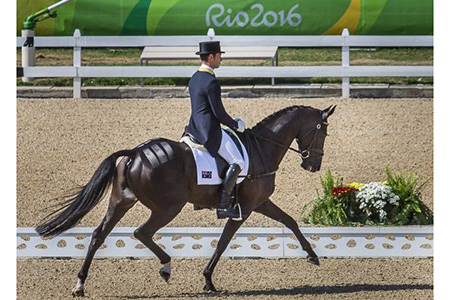
Back in 2006, we did this article with Chris Burton, working at home in Glossodia, and working with an off-the-track Thoroughbred. Since then, he’s won at Aachen – twice, been a member of the Bronze Medal team in Rio, and many more international successes. He won a World Champion Young Event horse title with Firefly in 2016. He is now based in the UK, with his wife Bek, and young son.
Pix Ros Neave Words Christopher Hector
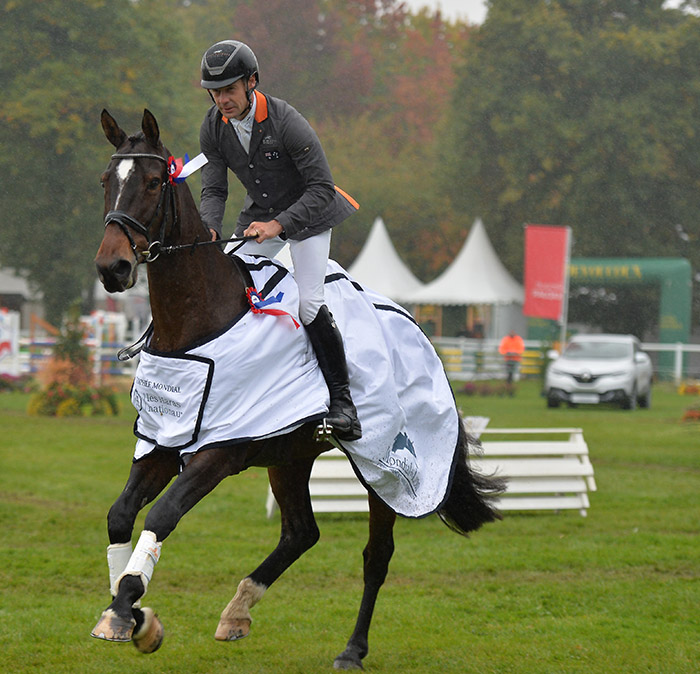
Christopher Burton is a ‘thinking rider’ and it was no trouble for him to explain his simple, easy to follow warm up routine. A warm up that will work for any horse – eventer, showjumper or dressage – and improve performance every time.
Christopher’s model for his demonstration was Walk the Line, alias Johnny – a 6 year old, Thoroughbred ex-racehorse, destined for a career in Eventing.
According to Christopher: “Johnny is an interesting mix. He’s a sensitive Thoroughbred but like most horses he can easily get lazy.”
“The first thing I do is get the horse going forward. Lots of riders are obsessed with getting them round – I’m not, I just want forward. I don’t always ride with a whip, but I keep one by the arena in case I need it. Most of the time just picking the whip up is enough to get him thinking forward…”
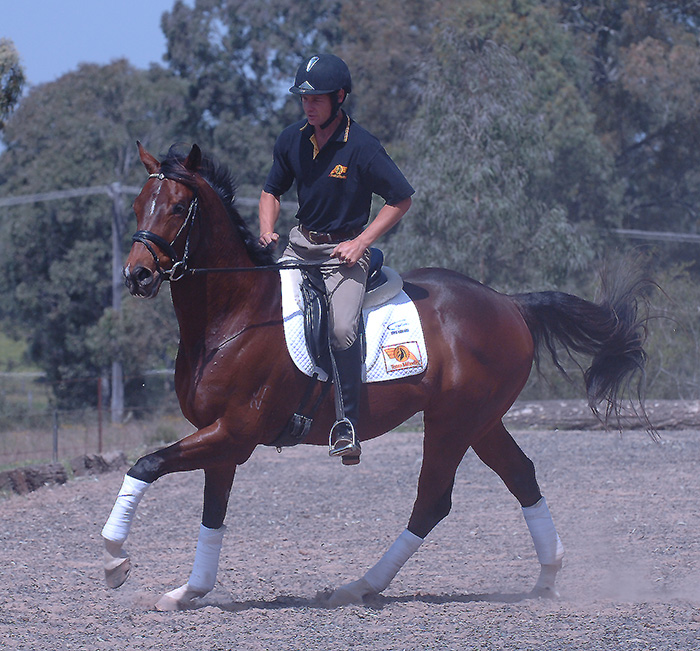
And right on cue, Johnny does a little freak on the whip and a minor take off!
“I start in rising trot, he’s still young. Get him soft and supple and happy. I try to get him used to this warmup then when I take him somewhere strange like a competition, even though it might take a little longer, he settles down because he is used to the routine of the warmup. There’s no pressure at this stage, just long, looking down, listening to me.”
“As the warmup progresses, I ask a bit more round, pressure him a little from behind but only after he’s thinking forward – and thinking forward for himself because I don’t want to be kicking him forward all the time.”
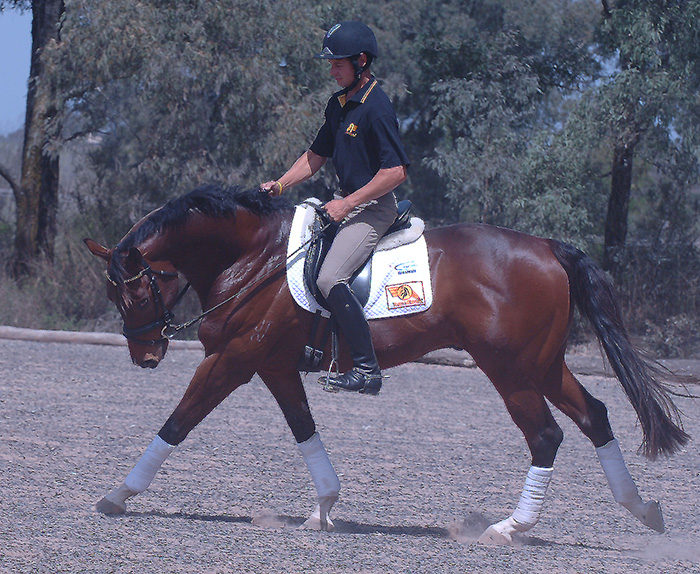
“Okay a fit three star horse will get a bit more excited when you start to work, but if you have been using this same warmup all through their career, it lets them settle, and it also gives me an indication of when they are ready to pick up and go to work. Establish the routine at home, and you end up with a horse with a healthy body and a healthy mind.”
“Right now he is a tiny bit against my right leg. In the warmup I’ll gently try to talk him around my right leg. Let him do it on his own rather than pressuring him into letting go.”
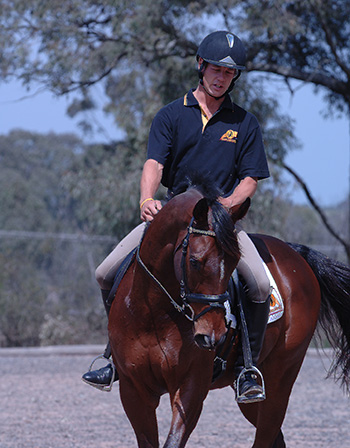
“Bend his neck for a moment to unlock, then let him go forward. I’m not fussed if he puts his nose in the air and has a little look around – it’s an amateur dressage mistake to be obsessed with how round the horse is. It’s not about getting the horse round, it’s about getting the horse to carry its head. I ride some horses that have had the round treatment and they are just dead to the rein, all they know is round, they know nothing about left or right, or half halts.”
“Now let’s move on to some transitions – simple, un-pressured transitions, uncomplicated transitions. We are just trying to get the horse more forward thinking but so it is his idea, so he enjoys it, so he is not dead to the leg.”
“For that upwards transition, I just squeeze my legs together – if he doesn’t respond, then I’ll use the spur. All the time, we want to keep it simple and at the same time, keep the aids, light.”
“Now I will work on some transitions within the pace. Can I slow the trot? Can I ride forward by giving and allowing forward? So many people lock their horses up with the emphasis on round that they lose the forward thinking. Forward and back in the trot. I want him to stay soft but he has the tendency to lock his neck, I want it soft, so he’s carrying his own head. So I can ride without reins and he should stay in a similar frame, in a similar straightness, the only change when I give away the rein should be that he stretches a bit more.”
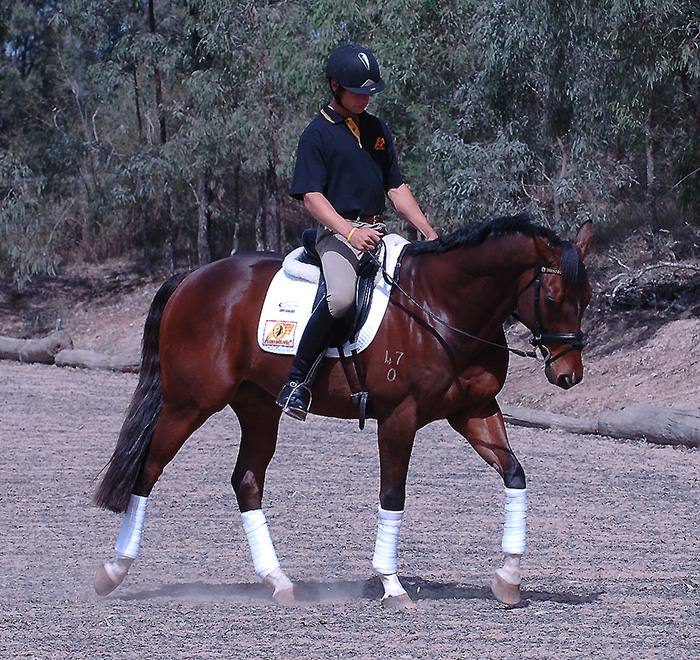
“To get that lightness, my body has to be very independent. He carries himself, I carry my hands. That means you are riding off your seat, and that comes after the basics are there. The breaker doesn’t sit into the horse’s back to slow down. He starts with the reins, and the horse learns reins = slow. Once he understands that, then I can brace my body, and achieve a downward transition without the reins. It starts off with a very clear understanding, you pull on the bit of metal in his mouth, and he slows down. Then to get the horse responding to your seat, you must have a very independent seat and that gives the horse the chance to think about your seat as an aid. Once the horse is listening to your seat, then he stays forward thinking in the transition down because you are not using your reins, just bracing your body.”
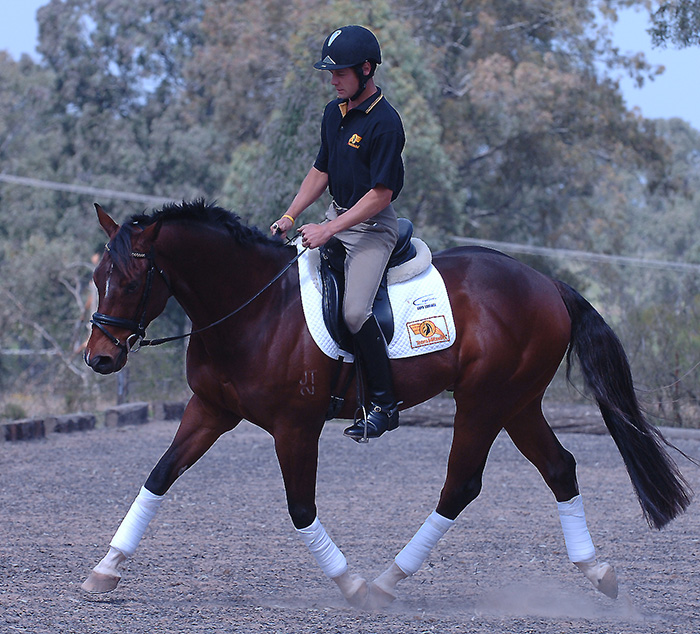
“It’s the same in the upwards transition. I don’t want my body flapping, legs pumping, to get an upwards transition. I want the horse so forward thinking that all I have to do is squeeze and allow.”
“Now I’ll ask him to put his neck a little lower, and we’ll have a canter. Again, off a gentle aid, sit, slide the outside leg back remembering that he can feel a fly on his skin so you hardly have to touch him, then off. It’s the same subtle communication you will need for the flying change. I allow him to go forward by my body going with him – and he is carrying himself, he is doing it on his own. I’m not physically making him do anything.”
At this point, Johnny decides to offer a leap in the air as an added attraction…
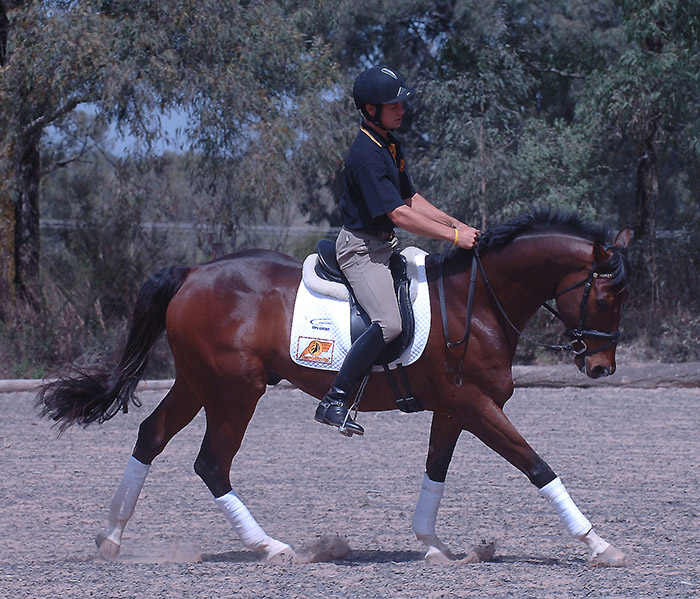
Chris laughs: “You can’t take that away from him, so you have to re-direct it, ‘you want to talk about extra energy? Let’s talk about medium trot.’ I didn’t scold him for playing up and being a young horse – I just turned a bad situation into something good – medium trot – and he didn’t even notice what I was doing. You don’t want to take that excitable energy away from a nice young horse because it is just that added brilliance that is going to leave the final fence up at the end of a tough three day.”
“I am trying to shape him more in the canter but I still let him carry himself, still let him think he’s doing it on his own and he’s not held together.”
“Let’s test the warmup by going back to trot…”
“Now I know that our warmup has been successful because there is more reach in the trot, and I never discourage that, never – I really like them to reach.”

While the warmup is a recipe for any horse, according to Christopher, it is particularly necessary for the talented horses:
“There are some horses that will get there with anyone riding them, but some are professional’s horses – they are the ones that need kid gloves to preserve the brilliance. Johnny is one of those horses. So I am careful to give him a breather to think about what we have done.”
Now it’s time to tighten the girth:
“In rising trot I don’t need the girth so tight, but now we need to tighten it, because I never want to bounce in the sitting trot. I hope the warmup has carried through and he is happier in the mouth and we can ask for more engagement. He’s very calm now so when I work him up and ask for more engagement, he should keep that relaxed feeling.”
“Sitting trot shouldn’t be any different from rising trot – elastic hips and back, so you become part of the horse.”
more follows
The picture looks nice, but Christopher is not entirely happy:
“He’s a tiny bit locked in front. I’m waiting for him to fold through the poll. I keep my aids very soft, just waiting, and once he yields I allow a tiny bit more.”
“Now we can have a little talk about the right leg issue. If he steps away from my leg, then I’ll take it off. And if he doesn’t step away, then a little spur. There, that was better.”
“At this stage, I ride lots of transitions, staying very secure with my body. Now the transition to halt.”
And in halt, Christopher is sitting there waiting for something to happen:
“I waited in the halt until he breathed, until he relaxed. He breathes and I pat him and let him settle. That way I can ride the hottest Thoroughbred – the ones we like on cross-country – and in the dressage test when I come to a halt at X, I feel him breathe and relax. They love that and as soon as they get the hang of it, that at every halt they get the chance to stop and breathe, they want to do it. Once they get the idea, they want to do it all day long.”
“Now I want to think about shoulder-in, just going with him – not asking for as much as he’s got, there is more there, but right now I want to keep the rhythm and the even steps. Expect less today and tomorrow you get more.”
While Johnny was happily standing there, Christopher talked about his major challenge:
“Canter is not his strongest gait. I hope it will continue to improve – I know he must have a good canter because he’s got such a good walk and trot. I’ve just got to keep him happy and explain the idea to him.”
Off into canter:
“The first thing is to allow him to go forward. He’s still a baby and he still falls in on the circle. So I work on bending and softening the poll. Right / left, trying to keep a light seat on him, and ask for a bit more activity, increase the jump.”
“I like to use a little canter pirouette exercise. Once he feels he is trying, let him feel free. Always let him feel there’s a way out, he’s a Thoroughbred horse and he’ll bottle up real quick if you give him a chance, but at the same time if I just go forward, he’ll run onto his face. I can’t use forward to make the jump bigger – I have to make him collect a bit.”
“On the left canter he is more balanced. So we try a few pirouette steps, then allow him forward, allow him to think free but always maintaining the balance. That’s nice I think he has done enough for today…”
And of course, the session finished with a lovely loose rein walk with the horse stretching his neck – it was the perfect warmup, especially, as Christopher stresses, for a potentially hot horse:
“Nice horses, they try but give them to an idiot, and they are crazy very soon – but those brilliant ones are the ones I want to ride. I see it so often when I am teaching, I get on the horse and think, well he’s almost ruined. You can’t help but think, could that horse have been brilliant if someone had done a better job? But with a talented young horse like Johnny, he’s got a good attitude, he wants to do it, but all I am doing is using that energy, that extra that he has, to work for me rather than against me.”
But it would be easy to bottle him up and make him anxious?
“Absolutely, it would be terribly easy to make his brains pop out his ears – only because he is all try. He wants to do it himself, so I use that by being tactful with my riding, and going with him, and letting him be free, letting him think that he is doing it on his own. That’s the biggest tool, that I am not physically making him do anything. You can’t make a horse do anything when you are on their back…”
It was interesting that the rhythm was very even and constant – right through the work…
“I definitely work at making rhythm my priority. I think with training, rhythm has to be the first thing that is there and it is just habit. Practice makes it so permanent that you don’t have to think about it. I wasn’t even thinking about rhythm today because I just have it – rhythm is there, that’s how I ride. I don’t want to have to think about it all the time, I have too many other things to think about – rhythm should just be there permanently in place. With all the horses, rhythm should be ingrained in them.”
Horses off the racetrack are not used to keeping a nice rhythmic frame?
“Sure, but that’s how you work with the horse, and that’s when it is important to know what level of horse you are riding. You should feel each day, what level of riding they are up to – that day – and what you can expect from them, so you can work on smoothing it all out.”
That must be hard with a horse like this, that you say you don’t want to bottle him up, yet when you start to ride him, being a racehorse, there must be times when he gets quicker because he hasn’t got the balance, and if all the time you are pulling on his head to bring him back into a rhythm, then doesn’t this create problems? How do you regulate rhythm without over-controlling the horse?
“Exactly. It’s just repetition, just practice. The more patient I am with this horse, and the less I expect of him, the more he gives me. I am asking him all the time to stay with me, but I am not expecting it always. If it doesn’t happen today, it will happen tomorrow… and he just gives more and more. Sure, there are times when they have to be told, “this is a bit of metal in your mouth and you do have to stop here”, but if that happens with him once a month that is fine. I just want to be very patient with him and have him stay with me and what I am doing.”
“What makes it possible to ride him without the apparent use of the aids, is that he knows through habit that we ride like this – so even when there are circus wheels and fireworks going off, I hope he can listen to that tactful gentle aid that I am using with my seat and body.”
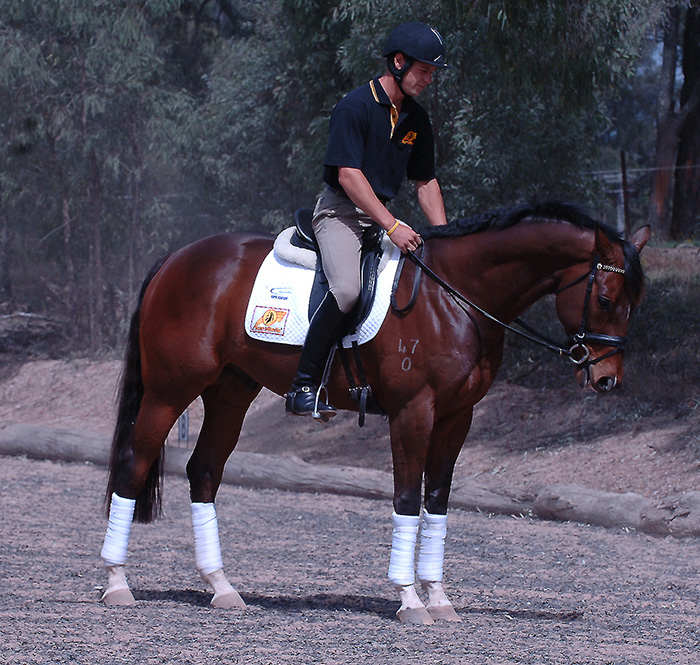
The halt, breathe and pat exercise, that’s part of this tactic?
“Yes, that is a very useful tool. I want him first to halt off a very gentle seat aid. Then he has to halt and maintain halt and then I wait for him to breathe, and that process gets quicker and quicker – I’ve had really hot advanced horses trained in that system, and it works. You’d think they’d be off their head in an indoor, or at a big Three Day when they are fit and ready to go. You halt at X, and you might just touch the horse, or just go through the sequence of aids, and you feel them breathe. They are standing there at X, they breathe and relax, and you know you are away… This is going to be the best test of my life.”
And with a warmup up routine like Christopher’s, you can work on making every test you ride, the best you can…

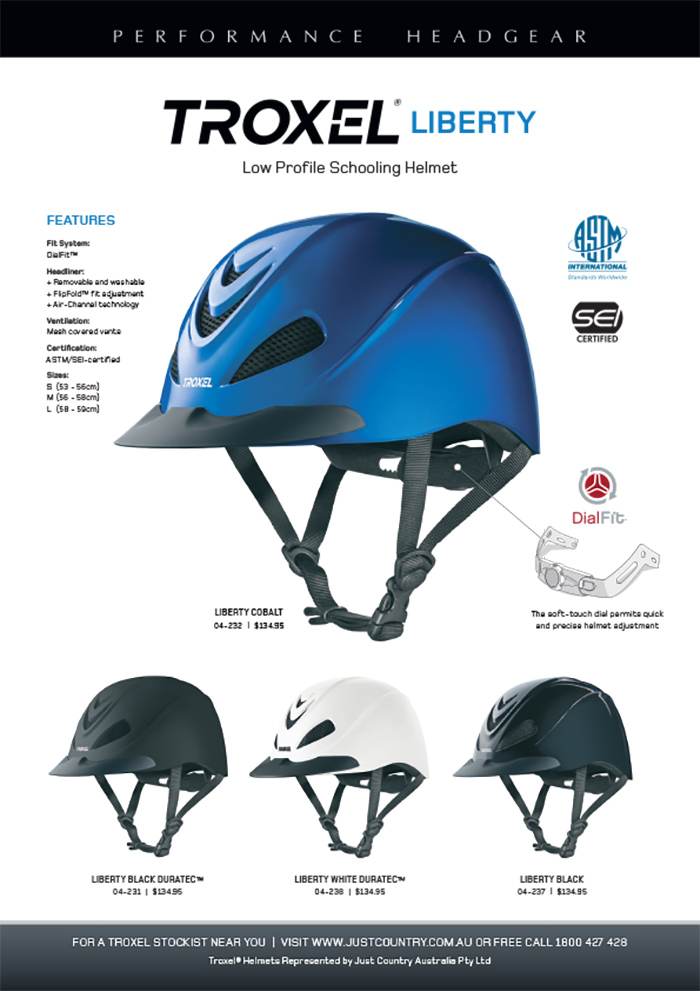
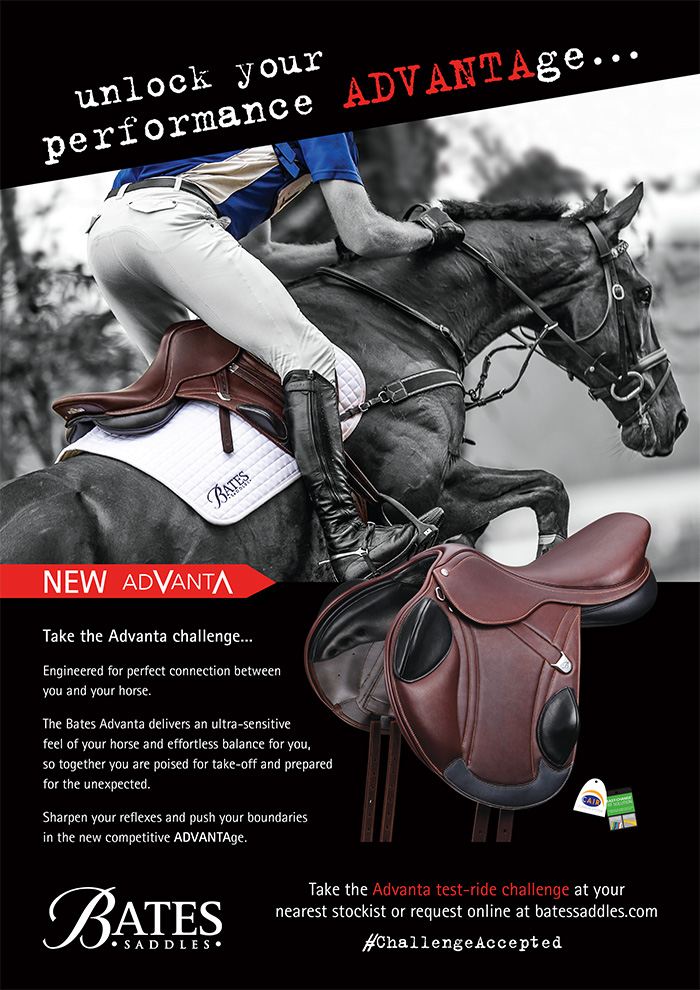
Hi there,
I was reading your warm up techniques, and I think I’m going to have to try this, I have a new horse, he us 7 but seems like he needs to be lounged before I ride and some, he has been trying to whip around, hesitant to go forward, but also my ride yesterday was an interesting one, he was carrying his head really long and almost too low in the trot, I gave him the rein, tried to keep him happy, never experienced anything like that, he is an experience and very well educated horse but seems that I’m having trouble with him just going forward, had a great ride on him last weekend at our first show but it seems things have turned to the worst and I don’t understand why.
I’d love your advise on this, I want him to go to a trainer, I would have sent him to work with maree thompkinson but she is competing at the WEG in France, so I’m thinking who now.
Your advise would be very helpful, thankyou, ps your horse us very nice in the pictures
Regards
Dalia
0412543760
My mob if you want to call re my situation.
Thanks again.